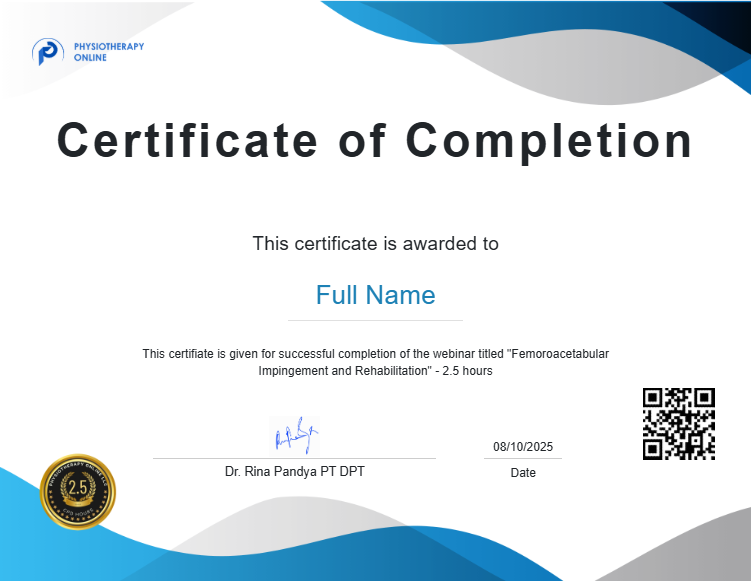About Course
Femoroacetabular Impingement and Rehabilitation Aims To
This physiotherapy Femoroacetabular Impingement and Rehabilitation webinar is designed to provide participants with a comprehensive understanding of Femoroacetabular Impingement (FAI) Syndrome, the most common cause of hip-related pain. FAI is a clinical syndrome that results in abnormal contact between the femoral head and acetabulum, leading to cartilage labral damage and hip pain.
FAI is often mistaken for osteoarthritis of the hip, making it a critical condition for physiotherapists to diagnose and treat accurately. Participants in this webinar will gain a deep understanding of the pathophysiology, population demographics, and symptomatology of FAI, covering Pincer, cam, and combination FAI.
The webinar will also delve into radiographic findings and evidence-based rehabilitation techniques. Participants will learn how to identify and diagnose FAI accurately, enabling them to develop targeted treatment plans that address the underlying pathology. The course is designed to provide practical skills and knowledge that participants can apply in clinical settings, improving patient outcomes and quality of life.
Topics covered in the webinar include:
- Pathophysiology of FAI Syndrome
- Population demographics and symptomatology
- Pincer, cam, and combination FAI
- Radiographic findings
- Evidence-based rehabilitation techniques
This webinar is ideal for physiotherapists who want to enhance their diagnostic and treatment skills for FAI Syndrome, providing them with the tools necessary to deliver better care for their patients. With a focus on practical skills and knowledge, this course is designed to help physiotherapists achieve better outcomes and improve the lives of their patients.
Learning objectives
- Differentiate between the pathophysiology of the three types of FAI (Pincer, cam, and combination FAI) to accurately diagnose FAI syndrome and develop targeted treatment plans.
- Identify the symptomology of the three types of FAI to improve diagnostic accuracy and develop effective treatment plans for patients.
- List three rehabilitation strategies for FAI to improve patient outcomes and quality of life, including evidence-based techniques for strengthening, flexibility, and pain management.
Who Should Enroll
- Physiotherapists
- Occupational Therapists
- Nurses, Physiotherapy assistants
- Occupational therapy assistants
CPD Credit Hours
2h 29 min
Author
Brian Schiff, PT, DPT, OCS, CSCS
Disclaimer: Our online physiotherapy courses meet the criteria and guidelines for CPD (Continuing Professional Development). The CPD hours indicated on the certificate contribute towards fulfilling professional standards and requirements necessary for CPD audits conducted by the HCPC and AHPRA. These CPD hours are important for maintaining physiotherapy registration and ensuring compliance with CPD audit and Physiotherapy registration renewal processes. Our courses are recognized as valuable continuing education resources across the UK, Australia, New Zealand, and throughout Asia and the Middle East.


